PEER REVIEWED
Impact of Clinically Centered Microbiology and Immunology Coursework on Student Perceptions
and Learning Outcomes
Michelle Demory Beckler, PhD, Beata I. Lewandowska OD, MS, Pranati Movva, MS, and Joshua M Costin, PhD
Abstract
With the expanding medical scope of optometric practice, a strong foundational understanding of microbiology and immunology is crucial for optometrists entering the profession. We designed an interdisciplinary curriculum taught by microbiologists, immunologists and clinical optometric faculty that vertically integrated clinical content with basic science concepts. Learning outcomes and student interest were evaluated utilizing survey and summative assessment data. Students had a greater prior background in microbiology than in immunology. Integration of the subjects was well-received and correlated with final grades. Students believed these subjects were important to their careers. This design could serve as a model for other optometry programs.
Key Words: microbiology, immunology, curriculum, clinical integration, vertical integration, interdisciplinary, basic sciences, optometry, education
Introduction
For learners entering programs in health professions who have limited or no clinical exposure to patient care, the knowledge gained through the basic science courses is difficult to connect to clinical scenarios. This challenge can be overcome by linking basic science concepts to clinical problems, often through patient-based or case-based learning.1 Medical schools have realized the importance of including clinical tasks early in the curriculum and have termed the mixing of basic and clinical sciences as vertical integration.2 In a similar fashion, some optometry programs have moved away from the conventional mode of teaching preclinical didactic courses followed by clinical instruction to interlinking the clinical and basic sciences within the curriculum.3,4
Infections by a variety of microorganisms are a common etiology of eye diseases encountered in optometric clinical care.5 Optometrists must be knowledgeable in basic sciences6 and the recognition of the symptoms and signs of ocular infections by a variety of pathogens. On occasion, optometrists may need to collect specimens from the ocular surface and prepare them for delivery to a lab for analysis.7 In addition, optometrists develop care plans to eradicate the offending microorganisms, promote tissue healing by taking into account the patient’s immunological status, educate the patients and their families, and effectively communicate with other members of the healthcare team. Optometric clinics, as outpatient settings, must comply with infection prevention guidelines to minimize the spread of infectious agents.8 The study of medical microbiology and immunology allows optometry students in their pre-clinical preparation to appreciate the various pathogens responsible for ocular infections as well as to understand the body’s immune responses against the infectious processes.
Two ways microbiology and immunology are taught in optometry programs are as a standalone course, such as the one offered by Nova Southeastern University’s College of Optometry (NOVA), or as topics within an integrated curriculum.3,4 Despite the importance of understanding microbiology and immunology as a foundation for other basic sciences and clinical concepts, some programs have reduced the number of hours for microbiology and immunology. NOVA has similarly seen a decrease in the number of hours for didactic lectures, with microbiology reduced from a 3-credit-hour course to a 2-credit-hour course during the 2019-2020 academic year. Considering the reduction in didactic hours or a reduced number of integrated hours of microbiology and immunology within a systems-based curriculum, it is becoming increasingly necessary for basic science course instructors to include vertically integrated, clinically focused course material in a very limited time frame to deliver a high-yield curriculum.
To emphasize the importance of microbiology and immunology to our pre-clinical optometry students, our goal was to integrate clinically correlated concepts and material into the course. We sought to design a clinically rich, standalone medical microbiology and immunology course that integrated clinical cases into didactic lectures and examinations.9 In addition, we collaborated with clinical optometric faculty to design co-lectures dedicated to the clinical application of microbiology and immunology to demonstrate the significance of the basic sciences to patient encounters. The clinical application of the basic science topics was assessed in summative examinations, and student satisfaction and perception were monitored by surveys. To the best of the authors’ knowledge, no published studies have examined the impact of vertical integration of clinical application in a medical microbiology and immunology course for optometry students.
Methods
Course structure and exams
Microbiology is a required 2-credit-hour first-year optometry course at NOVA. The course covers the basic immunology of the human body and the biology of microorganisms, incorporating a general medical approach to ocular diseases. In the Fall 2020 administration, the course content was delivered by a total of two microbiology, one immunology and two clinical lecturers. The microbiology and immunology lectures were delivered as didactic PowerPoint presentations with and without polling questions for engagement, depending on the lecturer and the topic. Foundational science material was presented covering basic concepts in immunology or microbiology with an overall emphasis on its clinical relevance and application of basic science to diseases using case studies and examples. A series of eight clinical co-lectures (CCLs) and case presentations were delivered by the clinical optometric faculty throughout the course and covered two topics each in immunology, bacteriology, virology and mycology (Table 1). These CCLs integrated foundational science information with clinical course and case presentations to highlight the application of microbiology and immunology body-wide, with an emphasis on the ocular region.
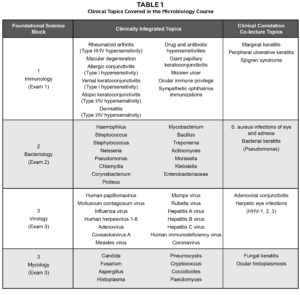
Table 1. Click to enlarge
Student performance was assessed by three written examinations of 40 multiple-choice questions per assessment, covering lecture presentations, assigned reading material and integrated clinical lectures. These examinations included questions that assessed students’ ability to integrate foundational information with clinical scenarios. The first examination tested immunology material (block 1) and contained six case-based questions, two of which came directly from the CCLs. The second examination tested bacteriology material (block 2) and contained 11 case-based questions, two of which came directly from the CCLs. The third examination tested virology and mycology material (block 3) and contained 12 case-based questions, two of which came directly from the CCLs.
Survey and exam administration
Institutional Review Board approval was granted for this study, which employed quantitative methods using surveys to assess student perception of course material as well as multiple-choice examinations to assess understanding and retention of the learning objectives. While class attendance and examinations were a course requirement, completion of the educational surveys as part of this study was not mandated, and students had the option to decline to answer each of the survey questions without penalty. Recruitment was restricted to the 129 students currently enrolled in the microbiology course in Fall 2020. Announcements to participate were made both during class and via the course page on the Canvas Learning Management System,10 making it clear that participation was entirely voluntary. No incentives were offered to participate. To minimize any potential feelings of coercion, it was announced that data would not be examined or analyzed in any fashion until the final grades for the course were released. All data were de-identified prior to analysis to protect student privacy.

Figure 1. Relative timing of surveys, exams and clinical co-lectures throughout the three blocks of the course. Black text = introductory and concluding surveys before and after blocks; Blue text = block 1 material and survey; Green text = block 2 material and survey; Orange text = block 3 material and survey.
Click to enlarge
Between August 2020 and December 2020, 129 students were enrolled in the microbiology course. Of these, 93 were female (72%) and 36 were male (28%). Figure 1 describes the relative timeline of events for the study. Surveys were designed and administered on ExamSoft, a secure testing digital platform.11 The first survey was administered at the beginning of the course to gauge students’ interest in microbiology and immunology and assess their prior knowledge of the subjects. The following three surveys were given after the delivery of the corresponding clinical correlate lectures and asked students’ perspectives on the course material, delivery of course content and perceived relevance to their careers. The second survey covered the perception of immunology (block 1). The third survey combined topics from bacteriology and virology (blocks 2 and 3), while the fourth survey was a concluding survey containing topics from mycology (block 3) as well as questions pertaining to students’ experiences with the course overall. In an attempt to lessen student survey fatigue, survey questions for block 3 were divided between the final two surveys, thereby eliminating the need for an additional survey to be administered. All surveys ranged from six to nine questions and were used to assess students’ perceptions of the importance and relevance of the subject matter and clinical correlation lectures to their future careers. Surveys used either multiple-choice time-frame options (0, 1, 2, 3, 4, or more semesters) or a Likert scale with four options (strongly agree, agree, disagree, and strongly disagree). Responses to four prompts were assessed: (1) How many semesters of microbiology did you take before starting in the College of Optometry? (2) How many semesters of immunology did you take before starting in the College of Optometry? (3) Medical immunology is important to my future career (4) Medical microbiology is important to my career.
Three multiple-choice examinations of 40 questions each were administered using ExamSoft throughout the semester. Exam questions based on the clinical lectures and case-based foundational lectures were administered as part of the regular examinations that assessed student understanding of the course learning objectives. One hundred and twenty total multiple-choice questions were administered over the course of the semester. Of those, six clinical case-style questions assessing the material presented during the case-based and clinical lectures were administered as part of the immunology exam, 11 as part of the bacteriology exam, and 12 as part of the virology and mycology exam. There were eight multiple-choice questions from a total of 120 exam questions based on the material delivered by clinical faculty – two from immunology, two from bacteriology, two from virology, and two from mycology. Table 1 lists the integrated topics covered on each exam.
Data analysis
Data were analyzed and graphed using GraphPad Prism version 9.1.1.12 Simple linear regression was performed on the raw data. A p value < 0.05 was considered significant. Simple descriptive statistics and tables were constructed using Microsoft Excel version 16.50.
Results
To determine whether the microbiology semester-long course redesign met the objectives of our study, four surveys were administered over the course of the semester (Figure 1). Data reported in this study were drawn from questions present on surveys 1, 2 and 4. Data from all other survey questions were inconclusive (data not shown). Not all students took all four surveys, and out of those who took the surveys, not all answered all questions. At the beginning of the course, 110 students responded to the questions “Medical immunology is important to my future career” and “Medical microbiology is important to my career” using a Likert scale with four options: strongly agree, agree, disagree, and strongly disagree (survey 1; 110 respondents, 85%). Students were then asked the same questions once the immunology (survey 2; 101 respondents, 78%) and microbiology (survey 4; 88 respondents, 68%) subjects were delivered.
Overall student response rate to microbiology course redesign
Anecdotally, there was noticeable excitement and increased engagement from students after each clinical lecture. Students voluntarily returned the surveys in large numbers. Survey 1, the pre-course survey, had 110 respondents (85%), survey 2 had 101 respondents (78%), and survey 4, the post-course survey, had 88 respondents (68%). Additionally, students performed well overall in the course with a class average of 82%.
Prior student experience in microbiology and immunology coursework
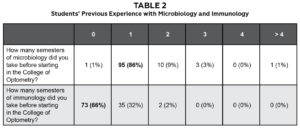
Table 2. Click to enlarge
Most students reported having some background in microbiology, with a majority of responding students (86%) reporting taking one semester of microbiology prior to matriculating in the College of Optometry. Fewer students had an immunology background, with a majority (66%) having never taken immunology, and 32% having taken only one semester of immunology prior to starting the optometry program (Table 2).
Assessment of students’ perceptions of the importance of microbiology and immunology
The results of the pre- and post-course survey question regarding student perception of the importance of medical immunology to their career indicated most students had a positive association and either agreed or strongly agreed (Figure 2). In total, there were 110 respondents to this question on survey 1 and there were 88 respondents to this question on survey 4. There were no statistically significant differences between the pre- and post-surveys (paired t test, p > 0.05) for this question. Perception of medical microbiology as important to their career also indicated that most students had a positive association and either agreed or strongly agreed (Figure 3). In total, there were 110 respondents to this question on survey 1 and there were 88 respondents to this question on survey 4. There were no statistically significant differences between pre- and post-surveys for this question (paired t test, p > 0.05).
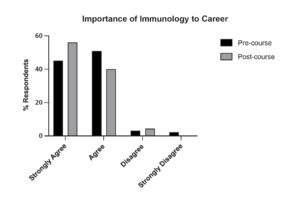 Figure 2. Student responses to the question “Medical immunology is important to my future career” given at the beginning (pre-course) or end (post-course) of the microbiology and immunology course. |
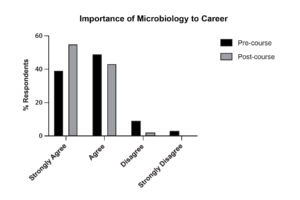 Figure 3. Student responses to the question “Medical microbiology is important to my future career” given at the beginning (pre-course) or end (post-course) of the microbiology and immunology course. |
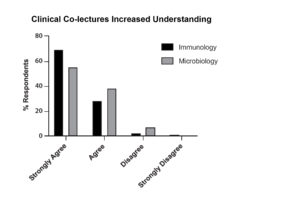 Figure 4. Student responses to the question “I feel incorporating clinical correlation into the medical immunology/microbiology section of this course is helpful to my understanding of the course material and how it will apply to my future career as an optometrist.” |
Students were assessed at the conclusion of the immunology (block 1) and microbiology sections (blocks 2 and 3) of the course about their opinions on the usefulness of integrating clinical correlations into the medical microbiology and immunology material with the questions “I feel incorporating clinical correlation into the medical immunology section of this course is helpful to my understanding of the course material and how it will apply to my future career as an optometrist” (survey 2) and “I feel incorporating clinical correlation into the medical microbiology section of this course is helpful to my understanding of the course material and how it will apply to my future career as an optometrist” (survey 3). Among 104 respondents, 97% responded positively to the statement that incorporating clinical correlation into the medical immunology section of the course was helpful to their understanding of the course material, with 69% strongly agreeing (Figure 4). Similar results were observed regarding the medical microbiology section with 93% of respondents responding positively to the statement and 55% strongly agreeing out of a total of 100 respondents (Figure 4).
Clinical case-style exam questions based on the clinical lectures and case-based foundational lectures were used to assess students’ understanding and appreciation of the clinical integration in this course. A total of 29 case-style questions were used. As students answered more clinically correlated questions throughout the course correctly, their final grades in the course increased in a linear fashion (Figure 5). Simple linear regression of the relationship is well-represented in a line of best fit with the equation Y = 1.975*X + 35 with a goodness of fit (R2) = 0.9527. This slope of the resulting regression line is significantly different from zero (p < 0.0001). Increased understanding of clinical application overall appears to increase understanding of all the material, including foundational material, indicating an increase in learning outcomes overall.
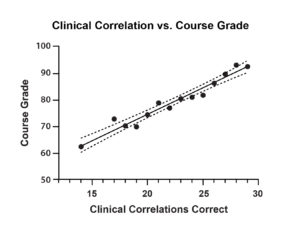 Figure 5. The plot of average course grade earned vs. the number of all clinical correlation questions from the course that students got correct on exams. Linear correlation was observed with a line of best-fit Y = 1.975*X + 35 with a goodness of fit (R2) = 0.9527 (n=129). The dotted lines show 95% confidence intervals. Click to enlarge |
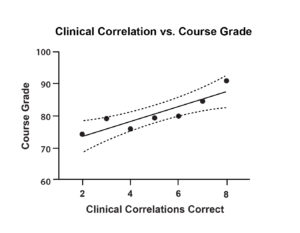 Figure 6. The plot of average course grade earned vs. the number of clinical correlation questions specific to the clinical co-lectures that students got correct on exams. Linear correlation was observed with a line of best fit Y = 2.343*X + 68 with a goodness of fit (R2) = 0.7961 (n=129). The dotted lines show 95% confidence intervals. Click to enlarge |
Further analysis of the questions strictly arising from the CCLs was also predictive of overall success in the course. Eight multiple-choice questions over the semester were based on the clinical faculty co-lecture material. Success on these eight questions was highly predictive of overall success in the course as measured by the exam average (Figure 6). Simple linear regression of the relationship is well-represented in a line of best fit with the equation Y = 2.343*X + 68 with a goodness of fit (R2) = 0.7961. This slope of 2.343 is significantly different from zero (p < 0.0001). Thus, using the number of correct responses to the clinical correlate questions exclusively as a proxy for increased understanding of the material is reasonable and objectively validates student feelings towards the clinical co-lecture material (Figure 4).
Discussion
This study is the first to elucidate the relevance of an integrated microbiology and immunology curriculum adapted to teach optometry students the knowledge necessary for their clinical practice. Previous studies have looked at integrating clinical education in microbiology coursework for medical students13; however, optometry students require clinical education in the classroom that matches their area of specialization. The overarching goal of our course design was to enhance student perception and performance within the course itself, which our data suggest was a success.
By introducing clinical material early in pre-clinical education, we sought to enhance our optometry students’ clinical knowledge. We believe this is particularly important given that with the aging U.S. population, optometric practices are likely to become more medically oriented and will play a larger role in the diagnosis and management of ocular infectious diseases.14 In addition, the knowledge gained through microbiology and immunology coursework is vital in complying with infection prevention guidelines and understanding how to protect optometrists, staff and patients from infections commonly spread in optometry practices.
The most current curriculum comparison of U.S. optometry schools was published in 2003 and discussed a reduction in the number of hours for didactic studies in the 2001-2002 school year when compared with previous years (1991-92 and 1995-96).15 Our program has seen a similar shift. We believe one way to make a standalone microbiology and immunology course successful and meaningful to optometric student education is to mimic the vertical integration seen in programs that use systems-based curricula. Therefore, we used a two-pronged approach in the design of our microbiology and immunology course.
This study incorporated a quantitative approach, which allowed course instructors to evaluate students’ perceptions of the usefulness of the integrated model to learning through survey-based questions and student feedback as well as quantitative evaluation through exam scores. Survey responses gave insight into students’ perceptions of the relevance of the coursework. This metric was important to evaluate because it has been shown that when students perceive what they are learning matches their goals, they are more likely to engage with the material presented to them.16 Students found the clinical integration useful, and this was reflected in the individual exam scores that increased linearly with increased performance on clinical lecture-based questions. Thus, introducing clinical lectures into microbiology and immunology coursework appears to improve student engagement and performance in the course. It is important to note that this was achieved without any additional resources or budget as clinical optometric faculty are commonly employed by optometric programs. There is a cost associated with faculty time devoted to providing clinical lectures. However, in our program, clinical faculty are given service hours to the college that allowed them to participate in the course.
According to the 2020 Association of Schools and Colleges of Optometry’s “Optometry A Career Guide,” microbiology, but not immunology, is a common prerequisite course for admission to U.S. optometry programs.14 Therefore, most students enter optometry programs, including ours, with a baseline knowledge of microbiology. In our study, students’ prior knowledge of microbiology was not quantitatively assessed before the start of the course; therefore, it is possible that their previous level of exposure to microbiology could impact their perception of the relevance of the coursework and their performance on assessments in the course. Results of the pre- and post-course survey question regarding students’ perception of the importance of medical immunology to their career in our study were not significantly different from each other (paired t test, p > 0.05) in large part due to an overwhelmingly positive agreement to the question. However, it was notable that while overall student perception of the importance of medical immunology to their career was 95% (pre-course) and 96% (post-course) positive, the course increased the number of students who “strongly agreed” by 11% and eliminated all answers of “strongly disagree.”
The perception of medical microbiology as important to the students’ career was also not significantly different before and after the course (paired t test, p > 0.05) due in large part to a strong positive response to the question with 88% of students either agreeing or strongly agreeing. However, there was a 10% increase in positive perception to 98% of total respondents who were asked if medical microbiology was important to their career after the course. Among positive respondents, 16% more “strongly agreed” after the course, and there were no longer any students who “strongly disagreed.”
Future studies should address this concern. The relative dearth of research articles regarding optometric curricula also appears to echo this lack of emphasis. At the same time, there is a wealth of research articles regarding microbiology and immunology in other health professions, particularly regarding clinical correlations of the material.13,17 In addition, the current study was limited in scope to one class in one optometry program in the United States. It would be illustrative to see the results of a longitudinal study in multiple programs across the country to see whether these results remain consistent and are widely applicable.
Conclusions
At the beginning of our course, most students had prior experience taking microbiology courses, while few had the same previous experience taking immunology courses. Irrespective of that prior experience, most students believed both subjects were important to their future career as optometrists. Vertical integration of clinical content throughout the foundational course in microbiology and immunology was well-received by the students. In addition, students’ course performance was positively impacted by the clinical integration as measured by performance on examinations. While not directly assessed, our results suggest that a clinically focused microbiology and immunology course in an optometric program, and not simply prerequisite microbiology, can positively impact students’ learning experience in their preclinical years. It remains to be seen whether this success carries over into subsequent, more clinically focused courses as well as students’ careers as optometrists.
Given our results, a multi-institutional, longitudinal study looking at the impact of clinically focused microbiology and immunology courses in optometric programs vs. only pre-requisite microbiology on academic and clinical performance is warranted. Future studies may also consider different clinically based integrations, such as case-based, team-based and problem-based learning approaches to promote discussion, invite questioning and encourage self-directed student learning.
References
- Brauer DG, Ferguson KJ. The integrated curriculum in medical education: AMEE Guide No. 96. Med Teach. 2015 Apr;37(4):312-22. doi: 10.3109/0142159X.2014.970998.
- Vidic B, Weitlauf HM. Horizontal and vertical integration of academic disciplines in the medical school curriculum. Clin Anat. 2002 May;15(3):233-5. doi: 10.1002/ca.10019.
- Nehmad L, Appel J. The integrative track at SUNY State College of Optometry. Optometric Education. Summer 2011;36(3):146-151.
- Rashima A, Krishnakumar R. Innovations in optometric education. Sci J Med & Vis Res Foun. 2016 Feb;34(1):11-14.
- Armstrong RA. The microbiology of the eye. Ophthalmic Physiol Opt. 2000 Nov;20(6):429-41.
- Twa MD. Optometry and biomedical sciences. Optom Vis Sci. 2018 Nov;95(11):975. doi: 10.1097/OPX.0000000000001313.
- Ogu AN, Okereke JN, Ogwunga CC, Anyadoh-Nwadike S. Bacteria associated with ocular infections of out-patients visiting optical clinic in Owerri, Imo State, Nigeria. Res J Sci Technol. 2022;04(01):019-030. doi: https://doi.org/10.53022/oarjst.2022.4.1.0056.
- Fernandes P, OYong K, Terashita D. Understanding infection prevention practices in optometry clinics. Optom Vis Sci. 2020 Jan;97(1):24-27. doi: 10.1097/OPX.0000000000001464.
- Chamberlain NR, Stuart MK, Singh VK, Sargentini NJ. Utilization of case presentations in medical microbiology to enhance relevance of basic science for medical students. Med Educ Online. 2012;17. doi: 10.3402/meo.v17i0.15943.
- Canvas [Internet]. Salt Lake City, UT: Instructure, Inc.; c2022 [cited 2022 June 13]. Available from: https://www.instructure.com/higher-education/products/canvas.
- ExamSoft [Internet]. ExamSoft Worldwide LLC; c2022 [cited 2022 June 13]. Available from: examsoft.com.
- GraphPad [Internet]. GraphPad Software; c2022 [cited 2022 June 13]. Available from: graphpad.com.
- Melber DJ, Teherani A, Schwartz BS. A comprehensive survey of preclinical microbiology curricula among US medical schools. Clin Infect Dis. 2016 Jul 15;63(2):164-8. doi: 10.1093/cid/ciw262.
- Optometry A Career Guide [Internet]. Rockville, MD: Association of Schools and Colleges of Optometry; updated August 2020 [cited 2022 June 13]. Available from: https://optometriceducation.org/pdfs/careerguide-august-2020.pdf.
- A Curriculum Comparison of US Optometry Schools: Looking Back Over the Decade [Internet]. Forest Grove, OR: CommonKnowledge, Pacific University Library; c2003 [cited 2022 June 13]. Available from: https://core.ac.uk/download/pdf/212801488.pdf.
- Frymier AB, Shulman GM. What’s in it for me?: Increasing content relevance to enhance students’ motivation. Commun Educ. 1995 Jan;44(1):40-50. doi: 10.1080/03634529509378996.
- Durrant RJ, Doig AK, Buxton RL, Fenn JP. Microbiology education in nursing practice. J Microbiol Biol Educ. 2017 Sep 1;18(2):18.2.43. doi: 10.1128/jmbe.v18i2.1224.




